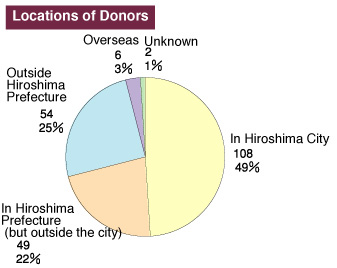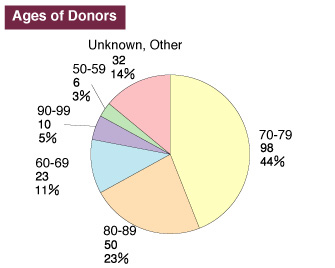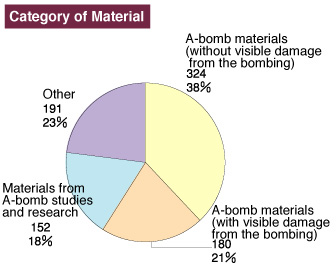| Hiroshima Peace Memorial Museum Collection Materials |
 |
|
 |
|
 |
- About half of the donors resided in Hiroshima City.
- Many donors in Hiroshima Prefecture resided in nearby cities and towns: nine in Hatsukaichi City, six in Fuchu-cho, and five each in the cities of Kure, Fukuyama, and Higashihiroshima.
- Outside Hiroshima Prefecture, the areas with the most donors are, in descending order: Tokyo-15, Yamaguchi Prefecture-8, Kanagawa Prefecture-5, Hyogo Prefecture-4, and Osaka Prefecture-3.
- Some donations came from overseas: three from the USA, two from the UK, and one from Canada.
|
|
- Donor 60 years or older comprised 83% (181 persons) of the total.
It is surmised that as the survivors and their family members age, intergenerational concern rises over whether the experiences will be passed down.
|
 |
|
 |
- "A-bomb materials without visible damage from bombing" are articles of clothing or other belongings of the victims that were preserved by families in the absence of physical remains or items with the victims at the time of their death. Of all donations, 38% were in this category; 27% were donated as remembrances of the dead, and 11% were donated by a survivor.
- "A-bomb artifacts with visible damage from the bombing" accounted for 21% of the whole. Survivors donated 4%, while family members of victims donated 17%.
- "Materials from A-bomb studies and research" include roughly 40 personal items the city of Hiroshima discovered during excavation projects on Ninoshima Island, as well as notebooks, journals, photos, etc., kept by members of A-bomb damage survey teams and other investigators.
- The "Other" category includes wartime and postwar picture post cards, magazines, maps, and the like.
|
|
- The largest category was documents, 59% of all donations. These 150 items included textbooks, notebooks, letters, diaries, and 70 disaster and death certificates. The second largest category was clothing, 17%. The prevalence of documents is probably due to the ease of preserving them and the family's strong attachment. Most were closely associated with the deceased.
- Buddhist statues, Buddhist altar articles, knives and swords include Kannon statues, small rice bowl stands for altars, and military swords handed down in families.
- US military items include possessions of US soldiers exposed to the atomic bombing as prisoners of war.
|

The sponsors were unable to ask all donors their reasons for donating the materials, but most donors spoke to us about the situation at the time of the bombing and their hopes for peace.
To us their words communicated a range of emotions and psychological conflict. Clearly, the difficulty of preserving the item was far less important than the positive motivation--the desire to support peace education. |
|

